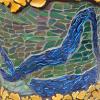Georgia Museum Highlights New Deal Art, And 'Color, Form and Light' Gets Down to Basics
Art Notes

“Panorama of the Plains” by Edward Chávez in “Celebrating Heroes”
In an effort to catalyze economic recovery, financial reform and unemployment relief following the Great Depression in the 1930s, President Franklin D. Roosevelt enacted a series of programs and regulations called the New Deal. One agency under its umbrella, the Works Progress Administration, specifically set out to create new jobs. Its visual arts arm, the Federal Art Project, commissioned roughly 10,000 artists to make murals, paintings, photography, graphic art, theater scenic designs and other arts and crafts, ultimately leading to the creation of over 100 community art centers across the country and approximately 200,000 new works of art. Three new exhibitions currently on view at the Georgia Museum of Art examine this significant era in American culture.
“Celebrating Heroes: American Mural Studies of the 1930s and 1940s from the Steven and Susan Hirsch Collection” includes nearly 50 drawings by artists, the majority of whom were associated with the Woodstock Art Colony in New York and employed by New Deal programs. Taking inspiration from Mexican muralists, who often romanticized everyday people as cultural heroes, these New Deal artists aimed to elevate the profiles of American Indians, farmers, miners and everyday workers through their larger-than-life depictions. Several of the pieces were submitted in mural competitions yet never executed, while others competed directly against each other, making for a unique opportunity to compare ideas.
The complementary exhibition “Larger Than Life: Mural Studies” offers a rare look into the processes behind designing large-scale works that exist to beautify and inspire the public realm. Various figure studies and sketches, sometimes even appearing on grid paper, show preliminary plans for magnificent murals whose completion can be observed on accompanying placards. Notably, two murals are staples in the Athens community. A black-and-white charcoal drawing by painter, muralist, musician and educator Art Rosenbaum spans an entire wall, serving as a study for “The World at Large,” a painting commissioned by the Willson Center for Humanities and Arts that is still on view in the UGA psychology building. Three charcoal portraits by Jean Charlot are also included to represent the artist’s fresco mural that adorns the exterior of the fine arts building on campus.
Specifically examining the cultural contributions of female artists during this time, “Women of the WPA” demonstrates how the agency fostered an important number of employment opportunities and leadership roles. In addition to describing their general body of work under federal programs, biographical information includes notable accomplishments and career highlights for several of the artists. Eleanor Coen, for example, went on to become the first woman to work for the Taller de Gráfica Popular in Mexico City, and Helen Lundeberg helped found the post-surrealist movement in Southern California. The influence these programs played in nurturing a more inclusive environment for women and progressing the production of art on a national level is clear. Other artists represented include Lucile Blanch, Grace Clements, Minetta Good, Mary Hutchinson, Dorothy Jeakins, Doris Lee and Elizabeth Olds.
In stark visual and conceptual contrast to the aforementioned exhibitions, “Color, Form and Light” focuses on artwork’s most basic elements. Drawn from the museum’s permanent collection and other rarely seen pieces on long-term loan, the exhibition reflects a range of overlapping artistic movements dating from the 1960s to the present, such as abstract expressionism and minimalism.
Appearing on the cover of Flagpole this week, De Wain Valentine’s monolithic sculpture “Double Concave Circle, Deep Red” stands alone within its own gallery space, commanding attention to its slick surface that playfully reflects and distorts its setting. Often associated with the Light and Space movement that arose in Southern California in the 1960s, Valentine was a pioneer of using industrial plastic and polyester resin to create translucent sculptures of minimalistic geometric shapes and vivid colors.
Victor Vasarely and his son, Yvaral, both experimented with illusion and perception through optical art, and their pieces can be found at the museum side by side. Nicknamed the “Grandfather of Op Art,” Vasarely has a screen print, “Tau-Ceti,” that appears to shift as one’s head moves forward and backward. His son’s sculpture, “Instability Number 18,” uses black and white patterns on vinyl cords to create the illusion of a three-dimensional pyramid as one’s body moves from side to side.
Fletcher Benton’s motorized “Synchronetic R-1000 (Rolling Discs)” is a wonderful example of kinetic art. As brightly colored translucent plexiglass discs slide from side to side, they produce new shapes and colors as they overlap and pass each other. Additional highlights in the exhibition include color field silkscreens by Jules Olitski and light sculptures by Lila Katzen and Nils Folke Anderson.
“Larger Than Life” and “Women of the WPA” will be on view through Sept. 8, while “Celebrating Heroes” extends until Sept. 15. “Color, Form and Light” can be experienced through Oct. 13.
More by Jessica Smith
-

Art Around Town
A list of local art exhibits.
-

-

Art Around Town
A list of local art exhibits.









comments